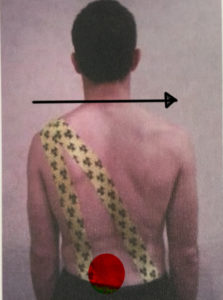For the most part, I usually cringe when I hear that one of our athletes is getting an MRI on their low back, because I never know exactly what it is going to tell us and what some physicians will want to do with the findings. I’m a firm believer that the vast majority of our population has some sort of a disc pathology in their low back that is completely asymptomatic. Oftentimes people with low back pain are having issues with some other mechanical issue or neurological irritation that has very little to do with a disc. The problem is that many doctors are so married to diagnostic imaging to drive their treatment plan, that those people will often get injections and/or surgery to correct a problem that doesn’t really exist and those procedures don’t actually solve their problem.
But, I do recognize that there are patients who have a true disc herniation or some other disc pathology that is truly problematic for them. These usually involve neurological symptoms the radiate down the leg with localized pain and spasm.
It really saddens me to see any of my young athletes who end up with one of these disc problems. This is because the vast majority of them will deal with this issue for the rest of their lives, even with a surgical intervention.
Of course we do everything we can to make them as healthy as we can so they can not only finish their playing career, but also so they can live healthy and productive lives for the long run. This typically includes mobility work, stability training, and managing neuro tension.
I have found another technique for treating these patients that has provided very quick relief from their symptoms in order to allow you to train all of the other components of their dysfunction. The first time I used this technique it was on a thrower on our women’s track team who had a symptomatic herniation at L4-L5. We tried the technique because we were having trouble making any real headway with any other treatments. To our delight, her active straight leg raise improved by 45 degrees within 24 hours and she reported a significant decrease in her symptoms. It gave us a great window of opportunity to work on her movement skills, stability and mobility.
The technique basically consists of a postural taping technique that we teach in Rocktape FMT courses for scoliosis. This technique works great for scoliosis, but it also works really well to unload the area of the low back when a disc is protruding and putting pressure on the nerve root.
 It starts with standing them upright and then shifting their shoulders away from the side that is symptomatic. In the example shown here, the patient is struggling with a left side herniation, causing neuro symptoms down his left leg. By shifting the shoulders to the right, we are opening the space on the left side of the spine in the low back.
It starts with standing them upright and then shifting their shoulders away from the side that is symptomatic. In the example shown here, the patient is struggling with a left side herniation, causing neuro symptoms down his left leg. By shifting the shoulders to the right, we are opening the space on the left side of the spine in the low back.
At that point, we use a postural taping technique to encourage this continuous unloading as they go about their day. To do so, you will take 2 pieces of tape and run them diagonally from the left shoulder towards the right hip. You are basically looking to pull the 2 short points together while they are in a lateral deviated standing position. This will encourage them to stay off of the pressure causing position. I typically run 1 piece of tape to the general area of both PSIS’ for my anatomical landmarks. You can run your tape at a slightly steeper angle (working it more lateral) if you are looking for a more aggressive pull.
While this isn’t a cure all for every disc patient, I think that you will find that it does provide some short term relief for most and a lot of relief for some. Once you can reduce their pain, it is time to lock in permanent changes with corrective exercise.
Looking for more help? Schedule a consultation today!


Leave a Reply